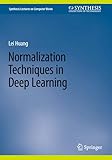Normalization Techniques in Deep Learning [electronic resource] / by Lei Huang.
By: Huang, Lei [author.] .
.
Contributor(s): SpringerLink (Online service) .
.
Material type:  BookSeries: Synthesis Lectures on Computer Vision: Publisher: Cham : Springer International Publishing : Imprint: Springer, 2022Edition: 1st ed. 2022.Description: XI, 110 p. 26 illus., 21 illus. in color. online resource.Content type: text Media type: computer Carrier type: online resourceISBN: 9783031145957.Subject(s): Computer vision
BookSeries: Synthesis Lectures on Computer Vision: Publisher: Cham : Springer International Publishing : Imprint: Springer, 2022Edition: 1st ed. 2022.Description: XI, 110 p. 26 illus., 21 illus. in color. online resource.Content type: text Media type: computer Carrier type: online resourceISBN: 9783031145957.Subject(s): Computer visionIntroduction -- Motivation and Overview of Normalization in DNNs -- A General View of Normalizing Activations -- A Framework for Normalizing Activations as Functions -- Multi-Mode and Combinational Normalization -- BN for More Robust Estimation -- Normalizing Weights -- Normalizing Gradients -- Analysis of Normalization -- Normalization in Task-specific Applications -- Summary and Discussion.
This book presents and surveys normalization techniques with a deep analysis in training deep neural networks. In addition, the author provides technical details in designing new normalization methods and network architectures tailored to specific tasks. Normalization methods can improve the training stability, optimization efficiency, and generalization ability of deep neural networks (DNNs) and have become basic components in most state-of-the-art DNN architectures. The author provides guidelines for elaborating, understanding, and applying normalization methods. This book is ideal for readers working on the development of novel deep learning algorithms and/or their applications to solve practical problems in computer vision and machine learning tasks. The book also serves as a resource researchers, engineers, and students who are new to the field and need to understand and train DNNs.


There are no comments for this item.